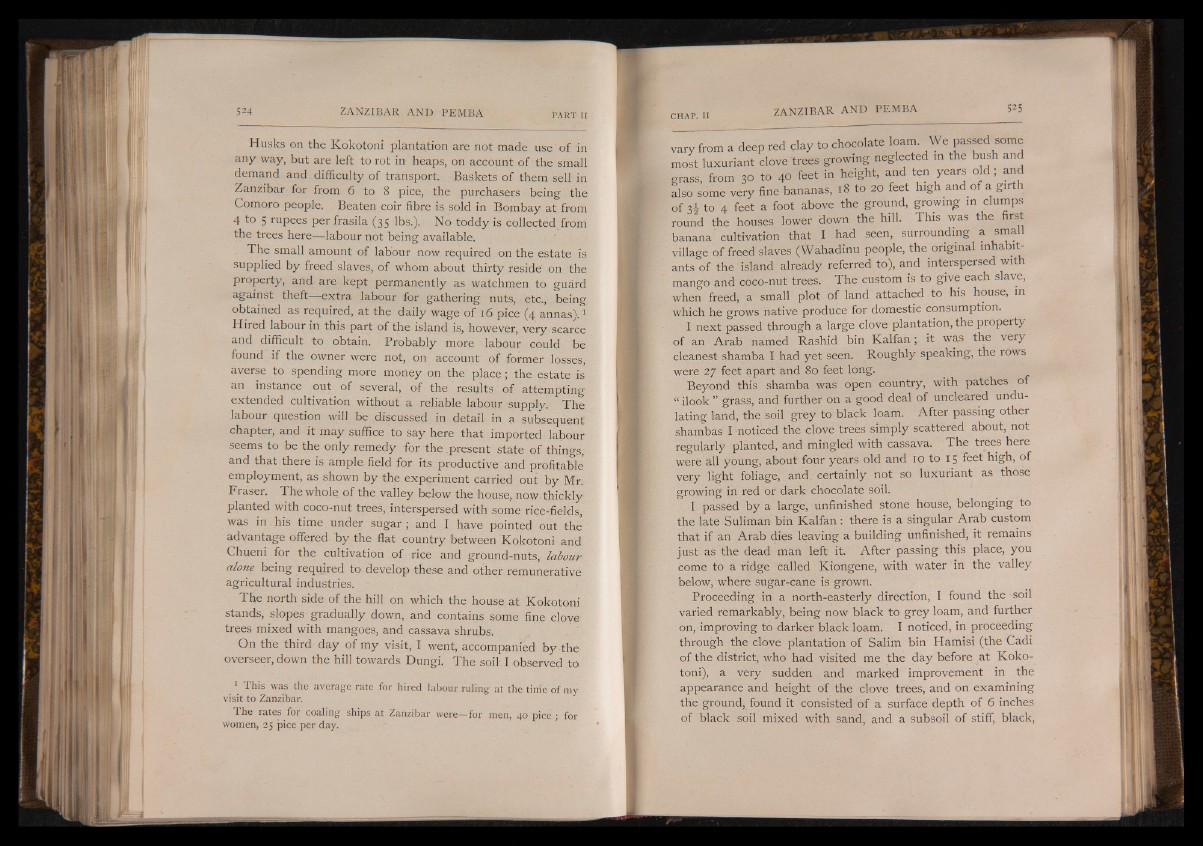
Husks on the Kokotoni plantation are not made use of in
any way, but are left to rot in heaps, on account of the small
demand and difficulty of transport. Baskets of them sell in
Zanzibar for from 6 to 8 pice, the purchasers being the
Comoro people. Beaten coir fibre is sold in Bombay at from
4 to 5 rupees per frasila (35 lbs.). No toddy is collected from
the trees here-—labour not being available.
The small amount of labour now required on the estate is
supplied by freed slaves, of whom about thirty reside on the
property, and are kept permanently as watchmen to guard
against theft -extra labour for gathering nuts, etc., being
obtained as required, at the daily wage of 16 pice (4 annas).1
Hired labour in this part of the island is, however, very scarce
and difficult to obtain. Probably more labour could be
found if the owner were not, on account of former losses,
averse to spending more money on the place; the estate is
an instance out of several, of the results of attempting
extended cultivation without a reliable labour supply. The
labour question will be discussed in detail in a subsequent
chapter; and it may suffice to say here that imported labour
seems to be the only remedy for the .present state of things,-
and that there is ample field for its productive and profitable
employment, as shown by the experiment carried out by Mr.
Fraser. The whole of the valley below the house, now thickly
planted with coco-nut trees, interspersed with some rice-fields,
was in his time under sugar ,' and I have pointed out the
advantage offered by the flat country between Kokotoni and
Chueni for the cultivation o f rice and ground-nuts, labour
alone being required to develop these and other remunerative
agricultural industries.
The north side of the hill on which the house at Kokotoni
stands, slopes gradually down, and contains some fine clove
trees mixed with mangoes, and cassava shrubs.
On the third day of my visit, I went, accompanied by the
overseer, down the hill towards Dungi. The soil I observed to
1 This was the average rate for hired labour ruling at the time of my
visit to Zanzibar.
The rates for coaling ships at Zanzibar were—for men, 40 pice ; for
women, 25 pice per day.
vary from a deep red clay to chocolate loam. We passed some
most luxuriant clove trees growing neglected in the bush and
grass, from 30 to 40 feet in height, and ten years old; and
also some very fine bananas, 18 to 20 feet high and of a girth
of 3i to 4 feet a foot above the ground, growing in clumps
round the houses lower down the hill. This was the first
banana cultivation that I had seen, surrounding a small
village of freed slaves (Wahadinu people, the original inhabitants
of the island already referred to), and interspersed with
mango and coco-nut trees. The custom is to give each slave,
when freed, a small plot of land attached to his house, in
which he grows native produce for domestic consumption.
I next passed through a large clove plantation, the property
of an Arab named Rashid bin Kalfan ; it was the very
cleanest shamba I had yet seen. Roughly speaking, the rows
were 27 feet apart and 80 feet long.
Beyond this shamba was open country, with patches of
“ ilook ” grass, and further on a good deal of uncleared undulating
land, the soil grey to black loam. After passing other
shambas I -noticed the clove trees simply scattered about, not
regularly planted, and mingled with cassava. The trees here
were all young, about four years old and 10 to 15 feet high, of
very light foliage, and, certainly not so luxuriant as those
growing in red or dark chocolate soil.
I passed by a large, unfinished stone house, belonging to
the late Suliman bin Kalfan: there is a singular Arab custom
that if an Arab dies leaving a building unfinished, it remains
just as the dead man left it. After passing this place, you
come to a ridge called Kiongene, with water in the valley
below, where sugar-cane is grown.
Proceeding in a north-easterly direction, I found the soil
varied remarkably, being now black to grey loam, and further
on, improving to darker black loam. I noticed, in proceeding
through the clove plantation of Salim bin Hamisi (the Cadi
of the district, who had visited me the day before at Kokotoni),
a very sudden and marked improvement in the
appearance and height of the clove trees, and on examining
the ground, found it consisted of a surface depth of 6 inches
of black soil mixed with sand, and a subsoil of stiff, black,